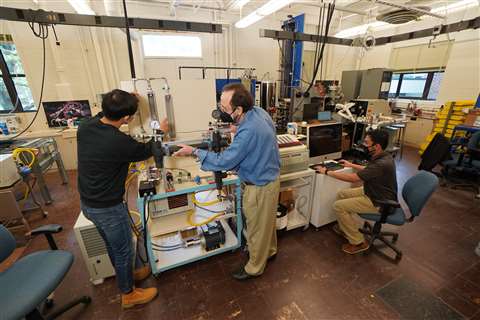Ford researching advanced BEV charging cables
11 November 2021
 Researchers working on the new charging station cable
Researchers working on the new charging station cable
Researchers from Ford Motor and Purdue University in West Lafayette, Indiana, have developed a new BEV charging cable design which could support reduced battery pack recharging times.
The cable uses liquid as a cooling agent. The liquid turns to vapour as the charging process continues, dissipating heat from the cable. This allows the charging station to deliver power at an increased rate. Specifics covering the liquid used were not revealed.
Changing the coolant from a liquid to a vapour is the key to delivering the increased charge. It is hoped the design could help deliver a battery pack recharge in the same time as filling a fuel tank.
“Today, chargers are limited in how quickly they can charge an EV’s battery due to the danger of overheating. Charging faster requires more current to travel through the charging cable,” said Michael Degner, senior technical leader, Ford Research and Advanced Engineering. “The higher the current, the greater the amount of heat that has to be removed to keep the cable operational.”
Ford stated that the technology could deliver significantly more power than today’s leading systems, if ‘vehicle charging and other technology enhancements are made in parallel’.
The cables are expected to enter a testing phase over the next two years to determine more specific charge speeds for various vehicles.
While the new technology is being aimed at Ford’s own BEVs, including the Mustang Mach-E, it is likely the technology could be used in various other applications, including recharging of battery-electric heavy vehicles, off-road machinery and battery gen-sets.
STAY CONNECTED




Receive the information you need when you need it through our world-leading magazines, newsletters and daily briefings.
POWER SOURCING GUIDE
The trusted reference and buyer’s guide for 83 years
The original “desktop search engine,” guiding nearly 10,000 users in more than 90 countries it is the primary reference for specifications and details on all the components that go into engine systems.
Visit Now
CONNECT WITH THE TEAM










